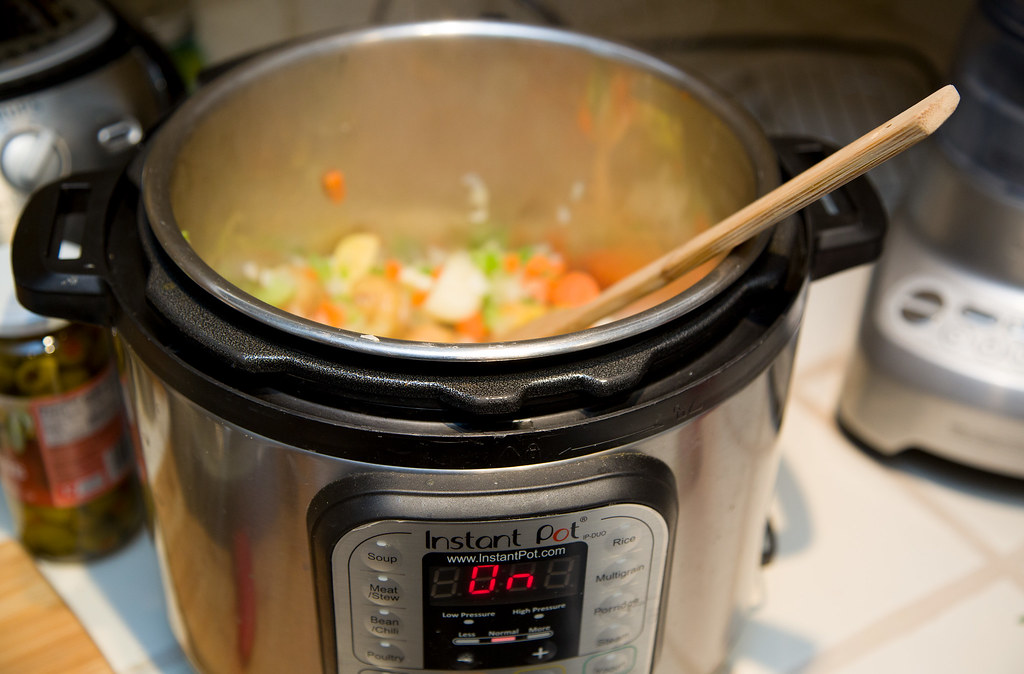Common Instant Pot Mistakes and How To Avoid Them
I use my Instant Pot constantly and thought I was completely past the initial learning curve. That is until I made applesauce last night. I did the quick release, as the recipe indicated, and left the room to do something, and came back only to find applesauce everywhere--on the wall behind it, on the counter below, even in the blinds by my kitchen window :( Lesson learned.

I think for many of us, when you first get your Instant Pot you are a bit intimidated by all the buttons and hissing and the high pressure aspect. I remember the first few times I used it, I cleared the room of anyone but me and was so scared the pot was going to blow up my kitchen. Ha! Trust me--it’s very easy and your pot will not explode. It is very simple to make all sorts of delicious food in no time in this beauty.
There are some common blunders that we all make with the Instant Pot, so whether you are a beginner or a seasoned veteran, here are a few of the most common Instant Pot mistakes and how to avoid them.
1) Overfill the Instant Pot

When it comes to the max fill line on an Instant Pot, you better stick to it or you may end up with a clogged Venting Knob and a big mess. In fact, in some cases you don’t want to fill it more than half way for foods that will expand when cooking.
*For pressure cooking: maximum ⅔ full
*For pressure cooking food that expands during cooking (such as grains, beans, and dried vegetables): maximum ½ full
If you did accidentally overfill the pot, don’t panic. Just make sure to use the Natural Pressure Release (which means you don’t flip the knob to “venting” at all. The pressure will slowly decrease and when the floating valve has dropped down, it is safe to open the lid).
2) Use Quick Release For Foamy Food or When It Is Overfilled
Here’s where we will address my applesauce mistake. There can be a chance of splattering if users use Quick Release when cooking certain foods like applesauce or soup or foamy food, such as grains or beans.
Solution #1: Use the natural release for foamy food or when the pot is overfilled.
But what do you do if you are making something like pasta and the recipe calls to have a quick release so it doesn’t overcook and get mushy??
Solution #2: Release the pressure gradually. You don’t have to turn the Venting Knob all the way to Venting Position to release pressure.
The initial release is usually the strongest so you can release the pressure gradually by turning the venting knob just a little bit with your hand or a wooden spoon until you hear a hissing sound. Keep it at that position to release the pressure gradually.
3) Food Left to “Keep Warm” Too Long

I can make the most perfect tender-crispy asparagus in 11 minutes from start to finish. You can do this by simply adding 1 cup water to the bottom of the pot, add your trivet, add your washed and trimmed asparagus, set the manual timer to 1 minute--it will take about 10 minutes to get to pressure and then after it cooks 1 minute, do a quick release.
Now, it turns out perfectly except for the one time I took a peek after the quick release and saw that it looked great, then put the lid back on, came back 10 minutes later to find yellowish, limp asparagus spears. What a bummer!
Solution: There are plenty of things like soups and meats that can sit in the lower pressure stage or keep warm stage and be just fine. However, more delicate things like vegetables or desserts like crème brule should be removed, as the final product could be compromised by too much time in the heat.
4) Too Much or Too Little Liquid
When it comes to liquids and cooking time, if you are trying to figure out your own recipe, it can be quite a game of trial and error. Things can turn out too watery, or even worse, if there is not enough liquid in the Instant Pot, it will not be able to work properly and get up to the pressure it needs to. There are so many amazing recipes out there on the internet, so thankfully some blessed soul out there has probably already found the perfect ingredient amounts and cooking times for you for any particular recipe you have in mind.
Solution: If you do find yourself with dishes that turn out too watery, or dishes that didn’t work at all because it never came to pressure, just remember that a general rule of thumb for liquid is starting with 1 cup water for most things. One cup is usually the perfect amount of liquid to come to pressure, and not be too watery.
Do you have any other tips for the Instant Pot to share with our friends? Or do you have any questions about any blunders you’ve run into in your Instant Pot adventures? Please share in the comments below.

I think for many of us, when you first get your Instant Pot you are a bit intimidated by all the buttons and hissing and the high pressure aspect. I remember the first few times I used it, I cleared the room of anyone but me and was so scared the pot was going to blow up my kitchen. Ha! Trust me--it’s very easy and your pot will not explode. It is very simple to make all sorts of delicious food in no time in this beauty.
There are some common blunders that we all make with the Instant Pot, so whether you are a beginner or a seasoned veteran, here are a few of the most common Instant Pot mistakes and how to avoid them.
1) Overfill the Instant Pot

When it comes to the max fill line on an Instant Pot, you better stick to it or you may end up with a clogged Venting Knob and a big mess. In fact, in some cases you don’t want to fill it more than half way for foods that will expand when cooking.
*For pressure cooking: maximum ⅔ full
*For pressure cooking food that expands during cooking (such as grains, beans, and dried vegetables): maximum ½ full
If you did accidentally overfill the pot, don’t panic. Just make sure to use the Natural Pressure Release (which means you don’t flip the knob to “venting” at all. The pressure will slowly decrease and when the floating valve has dropped down, it is safe to open the lid).
2) Use Quick Release For Foamy Food or When It Is Overfilled
Here’s where we will address my applesauce mistake. There can be a chance of splattering if users use Quick Release when cooking certain foods like applesauce or soup or foamy food, such as grains or beans.
Solution #1: Use the natural release for foamy food or when the pot is overfilled.
But what do you do if you are making something like pasta and the recipe calls to have a quick release so it doesn’t overcook and get mushy??
Solution #2: Release the pressure gradually. You don’t have to turn the Venting Knob all the way to Venting Position to release pressure.
The initial release is usually the strongest so you can release the pressure gradually by turning the venting knob just a little bit with your hand or a wooden spoon until you hear a hissing sound. Keep it at that position to release the pressure gradually.
3) Food Left to “Keep Warm” Too Long

I can make the most perfect tender-crispy asparagus in 11 minutes from start to finish. You can do this by simply adding 1 cup water to the bottom of the pot, add your trivet, add your washed and trimmed asparagus, set the manual timer to 1 minute--it will take about 10 minutes to get to pressure and then after it cooks 1 minute, do a quick release.
Now, it turns out perfectly except for the one time I took a peek after the quick release and saw that it looked great, then put the lid back on, came back 10 minutes later to find yellowish, limp asparagus spears. What a bummer!
Solution: There are plenty of things like soups and meats that can sit in the lower pressure stage or keep warm stage and be just fine. However, more delicate things like vegetables or desserts like crème brule should be removed, as the final product could be compromised by too much time in the heat.
4) Too Much or Too Little Liquid
When it comes to liquids and cooking time, if you are trying to figure out your own recipe, it can be quite a game of trial and error. Things can turn out too watery, or even worse, if there is not enough liquid in the Instant Pot, it will not be able to work properly and get up to the pressure it needs to. There are so many amazing recipes out there on the internet, so thankfully some blessed soul out there has probably already found the perfect ingredient amounts and cooking times for you for any particular recipe you have in mind.
Solution: If you do find yourself with dishes that turn out too watery, or dishes that didn’t work at all because it never came to pressure, just remember that a general rule of thumb for liquid is starting with 1 cup water for most things. One cup is usually the perfect amount of liquid to come to pressure, and not be too watery.
Do you have any other tips for the Instant Pot to share with our friends? Or do you have any questions about any blunders you’ve run into in your Instant Pot adventures? Please share in the comments below.
Sources:
- www.flikr.com
- www.pixabay.com
- www.pressurecookrecipes.com
 Mary Richardson
Mary Richardson
Weekly Newsletter Contributor since 2014
Email the author! mary@dvo.com
